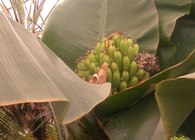Bananas and pineapples

The banana tree
10 May 2007
Bananas and pineapples
A banana tree that flowers and fruits every year and a pineapple plant may not be common sights in west Wales, but they are two of the attractions at the University's Tropical Glasshouse which opens its doors to the public as part of the Plas Penglais Open day on Sunday 13 May between 2 and 5 p.m.
As well as the Tropical Glasshouse, the open day is an opportunity to visit the grounds and the walled garden at the Plas. There will be a plant stall and home-made teas prepared by the Red Cross. Admission will be £2.50, children free. The open day is organised as part of the National Gardens Scheme which benefits a number of charities including Marie Curie Cancer Care, MacMillan Cancer Relief, The Nurses Welfare Service and the Gardeners' Benevolent Society.
Plas Penglais
Plas Penglais is a Georgian mansion set in roughly eight acres of lawns, amenity beds, rockery and woodland. The garden has a southerly aspect. Shelter belts, planted when the gardens were created in the late 1950's, are now mature and provide a microclimate on the south-facing three-acre field adjoining. Here many tender trees and shrubs thrive. At the lower end of the garden is a dingle with several mature, large-leaved Himalayan Rhododendrons. The ground is carpeted with bluebells in the spring.
The three-acre field was originally laid out as ‘order beds’ for teaching purposes for the University students. As teaching requirements changed, the beds evolved into amenity beds with more colourful and ornamental plants.
Of particular interest in the grounds are a Cork Oak, an evergreen Southern Beech-Nothofagus dombeyi, a fine collection of Japanese and mollis Azaleas, Rhododendrons, Pieris, and Ceanothus thyrsiflorus var. repens.
A sheltered walled garden contains a fine specimen of Beschorneria yuccoides, Abelia grandiflora, Pittosporum, Akebia quinata, Rosa ‘Alberic Barbier’ and Actinidia kolomikta.
In the amenity area beyond are collections of Ericaceous and Southern Hemisphere plants, Chusan Palms, Gunneras, Colletias, Tree Paeonies and many more unusual plants such as Daphniphyllum macropodum and Poncirus trifoliata.
The Tropical Glasshouse is part of the Institute of Biological Sciences and some of the plants growing in it, particularly the more primitive ferns and cycads, are used for undergraduate teaching purposes. However, there are many spectacular flowering plants grown purely for their ornamental value. These include Medinilla magnifica, the familiar Strelitzia reginae and the larger purple and white-flowered Strelitzia nicolai, Clerodendrum thomsoniae, Gloriosa superba, Aeschynanthus, Columnia, Streptocarpus, Anthurium and various species and hybrid orchids.
There is a collection of around 30 different Cacti and succulents and also a collection of Bromeliads including pineapple. Carnivorous plants are well represented, with Nepenthes, Sundews, Sarracenias, Venus Fly trap and Butterworts. There is a mature banana plant which flowers and fruits every year and many attractive foliage plants too, particularly members of the Maranta and Arum families.



